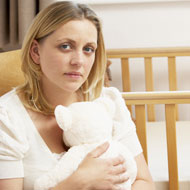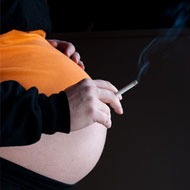Sudden Infant Death Syndrome
Sudden Infant Death Syndrome (SIDS) can be described as the rather sudden death of a seemingly healthy baby (under the age of 1 year), without any apparent cause. The unexplained death usually takes place when the child is asleep, which is why it is also commonly referred to as crib or cot death.
However, the infant does not die because of sleeping in a crib.
Sudden Infant Death Syndrome (SIDS) can be described as the rather sudden death of a seemingly healthy baby (under the age of 1 year), without any apparent cause. The unexplained death usually takes place when the child is asleep, which is why it is also commonly referred to as crib or cot death. However, the infant does not die because of sleeping in a crib.
The exact factors that cause the infant to die all of a sudden are still not clear. Health experts believe that the baby's death may be related to certain abnormalities in the part of the brain that controls breathing patterns and arousal from sleep. Though all babies are vulnerable to this syndrome certain sleeping environments could increase the risks.
Many parents believe that SIDS occurs in babies when they are sleeping on their back. However, this is just a myth; the truth is that you can reduce the risks of SIDS in your little one, by placing him on his back on a firm cot mattress, covered by a well-fitted sheet. Also avoid placing any other objects in the crib, including toys, bumper pads, extra pillows, bolsters and blankets. However, these steps only reduce the risks of SIDS to some extent; they cannot prevent it.
Sudden infant death syndrome causes
The exact causes of Sudden Infant Death Syndrome are still not clear. However, health experts believe that a combination of different Physical and Sleep Environmental factors could lead to SIDS.
Some of the Physical factors associated with SIDS include:
- Abnormalities in the brain: Some infants may be born with a problem where the part of their brain that manages breathing and arousal from sleep does not work properly. Infants suffering from this problem are more likely to suffer from SIDS.
- Low birth weight: Babies who are premature or a part of a multiple birth usually weigh a lot less than they normally should. In such instances, the baby's brain may not have developed completely. Because of this, the infant may not have complete control over automatic processes like breathing, thereby increasing risks of SIDS.
- Infections in the respiratory tract: Health experts claim that several children who died because of SIDS had been suffering from breathing problems caused by like the cold.
Some of the Sleep Environmental factors associated with SIDS include:
- Sleeping on the side or the tummy: Babies usually find it more difficult to breathe when they are sleeping on their side and tummy, as compared to their back.
- Sleeping on a soft mattress or surface: A baby's airways can get blocked in case he rolls over and lies face down on a fluffy comforter or a soft mattress. Covering the baby's face with a blanket could also cause breathing problems.
- Sleeping on the same bed as the parents: Adult beds are not safe or suitable for infants. Babies can roll over towards their parents and get suffocated while they are asleep. Extra pillows or blankets on the bed can also lead to breathing problems in the baby.
Risk factors for SIDS
Sudden Infant Death Syndrome can affect any baby under the age of 1 year. However, studies indicate that some babies are at a higher risk of this problem, as compared to others. Given below are some of the risk factors for SIDS:
- Age: Most of the deaths that are related to SIDS take place in babies who are 2 months to 4 months old. The risk of SIDS falls considerably once a baby crosses 6 months.
- Gender: SIDS is more likely to occur in boys than it is in girls.
- Race: Though the reasons are still not clear, SIDS is twice as prevalent in African American babies, as compared to white babies.amily histories: Babies from families in which siblings or cousins have died of SIDS may also suffer from the same problem
At times, the risks of SIDS could also increase in a child, because of certain maternal factors, which include mothers who
- Are below the age of 20
- Smoke
- Drink alcohol
- Use recreational drugs
- Did not undergo the right prenatal care
Preventing SIDS
There is no definite way to prevent SIDS in a baby, though a few measures may help keep it this problem at bay. Some of the possible ways of preventing SIDS include:
- Breastfeeding the infant exclusively, for the first 6 months of life
- Putting the baby down to sleep on his back
- Using a firm mattress in the baby's crib
- Getting rid of toys, bolsters, pillows and bumper pads from the baby's bed
- Ensuring that one end of the baby's blanket is tucked under the mattress, so that the blanket can't go above the shoulders
- Keeping the temperature in the baby's room cool
- Making sure that the baby sleeps in a crib, but preferably in the same room as you
Parents who have lost a child to SIDS usually require emotional support, mainly because they tend to blame themselves for their child's death. Family counseling is often recommended for the family members, to help the cope with the sudden and unexplained loss of an infant.


